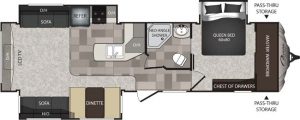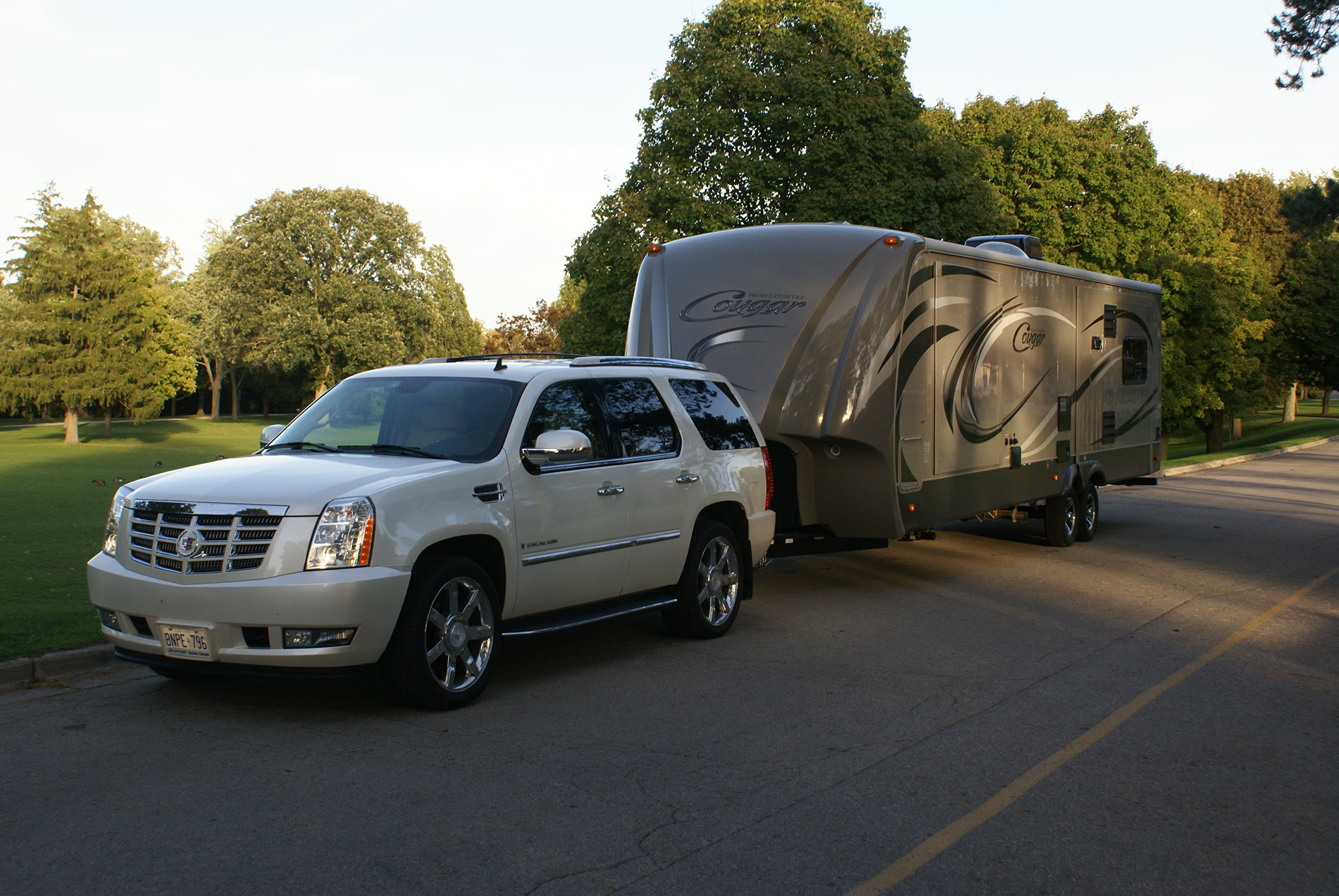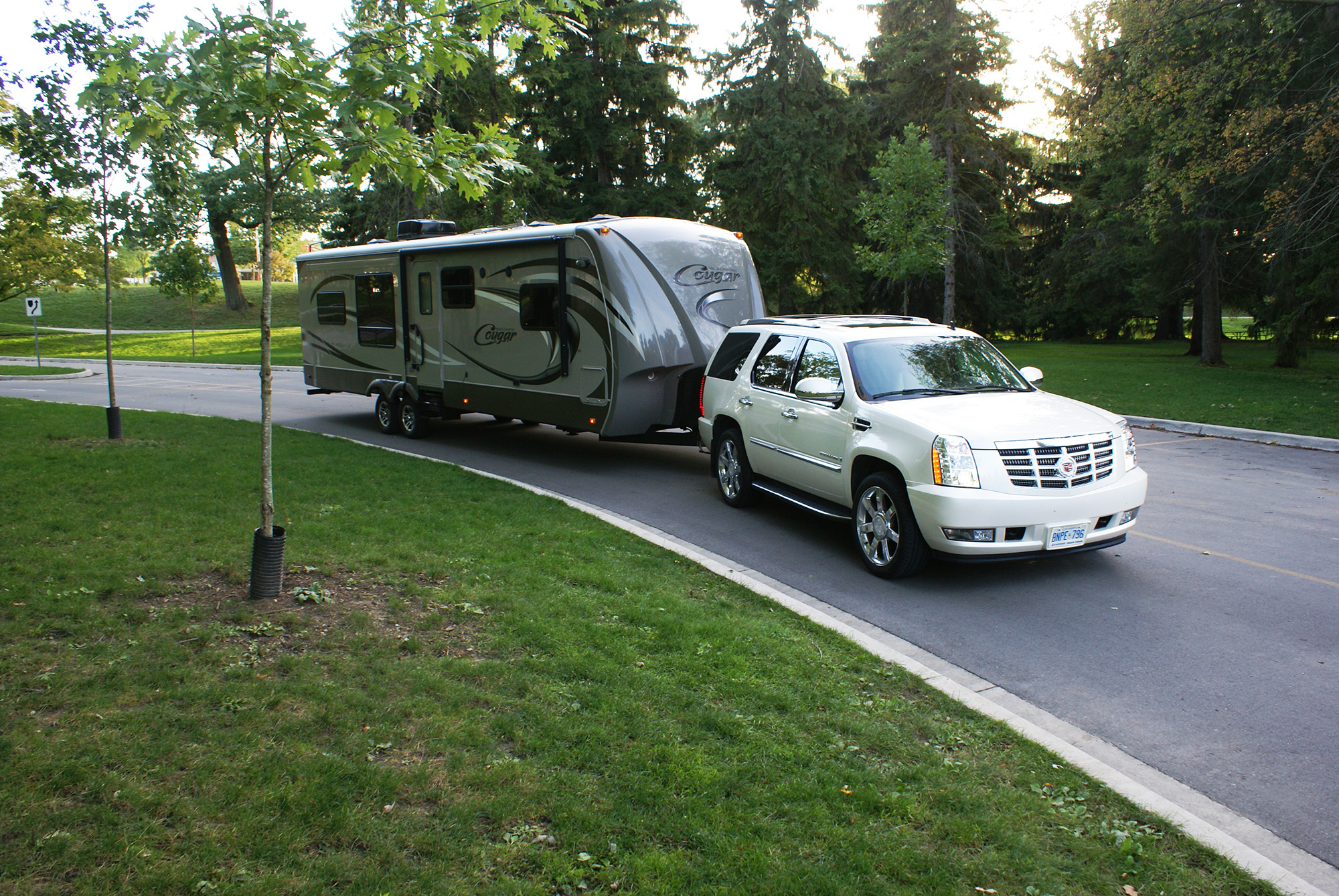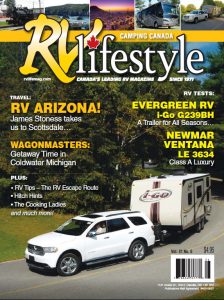A treasure from the RV Lifestyle Magazine archives…
This Hitch Hints column first appeared in Volume 41, Number 6, Summer 2011 – The towing concepts remain relevant in 2021
Looking for the ultimate Escalade accessory?
If you want to go big or go home, your obvious choice is a cool travel trailer!
When you decide to retire and spend some of the colder months down south, you want a big roomy RV to stay in – something you can travel with easily during the summer, and enjoy throughout your extended trips to the sunbelt. Fifth wheel trailers are the most common choice for this type of travel. The necessary interior appointments for most people include two swivel chairs plus a sofa with a free-standing dinette, a large galley and a roomy bedroom, ideally with a slide-out so you can have a closet that runs across the width of the trailer. Although fifth wheels with this type of floor plan are available from many of the RV manufacturers, most are going to need a three-quarter ton truck to tow them, which leaves you with a large pick up to drive the rest of the time. Some RV enthusiasts would like all this space and comfort in a travel trailer that would give them additional tow vehicle alternatives. The problem is that this often falls into the category of a pretty large and heavy trailer – not one designed for serious travel – most of the larger travel trailers are built with permanent campsites in mind.
 Last year (in 2010), Cougar introduced the 321RES High Country, featuring a very slick aerodynamic front cap. The use of composites in the construction helped keep the weight of this 35’ triple slide trailer down to 7700 pounds with 960 pounds of hitch weight. The stock package is pretty impressive, but for serious travel I would definitely add gas charged shocks and change the 15” travel trailer tires to 225/75R x 16” LT light truck tires, or maybe find the right 20’s to match a tow vehicle, like the Escalade that we used for this month’s article.
Last year (in 2010), Cougar introduced the 321RES High Country, featuring a very slick aerodynamic front cap. The use of composites in the construction helped keep the weight of this 35’ triple slide trailer down to 7700 pounds with 960 pounds of hitch weight. The stock package is pretty impressive, but for serious travel I would definitely add gas charged shocks and change the 15” travel trailer tires to 225/75R x 16” LT light truck tires, or maybe find the right 20’s to match a tow vehicle, like the Escalade that we used for this month’s article.
With that big front closet loaded, and propane in the tanks, the hitch weight of the 35’ trailer is closer to 1300 pounds – definitely too much trailer to hitch up to our Jetta Diesel. There are several tow vehicles that can carry 1300 pounds and provide a nice comfortable ride, besides the popular three-quarter ton pick up. You may be surprised to know that some of the smaller versions of full size SUV’s are excellent tow vehicles – for example, the Ford Expedition instead of the Expedition Max or the Tahoe instead of a Suburban. You may ask why you would want the shorter vehicle, isn’t a longer wheelbase better for towing? True, a longer wheelbase is better for towing if everything else is equal – but in the case of these vehicles with shorter wheelbases, the rear overhang is also shorter, so the percentage of the wheelbase to the rear overhang is about the same with the short and long versions so handling is equal.
Choosing a Hitch
The Cougar has full size slide-outs, so the floor height has to be above the tires. This raises the centre of gravity – not as high as a fifth wheel trailer, but well up there. The new aerodynamic front cap helps with stability but there is still a large amount of sidewall to catch cross winds and turbulence, so the best hitch to use by far is a Hensley. With the Hensley, passing trucks and crosswinds are barely perceptible. The 285 tires have reasonably soft sidewalls and while they are on 9” wide rims, the tire is much wider. Ideally, it would be nice to have something like a 255/50 tire that would fit the rim more precisely and reduce the rolling resistance, but there are no 22” tires available in that size, maybe by the time the tires need replacement there will be more variety! Still, the combination rides very smoothly and the handling is very good, to the point you have to remind yourself that you are towing a 35-foot trailer.
It is much easier to transfer weight on a vehicle with a shorter wheelbase and short overhang, so moving some of the 1300-pound hitch weight to the front axle is easily accomplished. These shorter SUV’s are hundreds of pounds lighter than the longer versions, but they use the same chassis and running gear. This gives them more load capacity and less body flex. The Escalade that we tested has a 4100-pound rear axle capacity and 3550 front capacity, so it can carry 7650 pounds if you can distribute it perfectly. This is almost 2000 pounds over the Escalade’s 5700-pound curb weight. The huge P285/45R x 22” tires can carry 2337 pounds each or 4674 pounds per axle – well above any weight they you may want to carry. We loaded the front of the Cougar until the hitch weight was at 1300 pounds and then we weighed the axles. The front axle of the Escalade was carrying 3310 pounds and the rear 3740. There is still load capacity for reasonable cargo and additional people in the Escalade.
Another advantage of the short versions of full size SUV’s is that you can maneuver into much tighter campsites and fuel stations than you can with the long wheelbase tow vehicles. In fact, this entire combination can make a U-turn in less space than some pickups solo. The rig featured in this article executes tight maneuvers very well for a 35’ trailer, so combined with the lower overall height and the Hensley hitch it opens up range of campsites that you would not normally get into with a full size fifth wheel.

If you choose a Tahoe or Expedition, you will have a choice of either the 5.3 or 5.4 litre motors mated to a 6-speed automatic, both of which will handle this Cougar nicely. Of course, an Escalade has to have attitude and an engine to back it up, so they come with a 6.2 litre V/8 with a whopping 403 horsepower and 417 pounds of torque. This motor has nothing overly advanced about it, no turbo or multiple valves with overhead cams. It does have variable valve timing, which I think is pretty rare on a pushrod engine. What they have done is optimize every aspect of a simple engine design; the result is so impressive that a version of the engine is used in the Corvette. With the Cougar in tow, the Escalade knocks off 0-100 KPH in 19.8 seconds, which is really moving when you are towing a trailer of this size – so you really have way more power than you need, but there are those who would ask – can you ever have too much power?
The Escalade is not a fuel miser, but it is more efficient than you might think, with that 6.2 litre engine in a big SUV. At 105 KPH solo it turns in 11.4 L/100 or 20.7 Miles per U.S. Gallon or 25 mpg if you still think in terms of the Imperial Gallon. If you take it easy, the mileage is in line with the current three-quarter ton diesels. The 6-speed transmission undoubtedly helps a great deal, but the steamroller tires likely hurt a little. While towing the big Cougar our fuel efficiency was about what you would expect – we logged 22.6 L/100km or 10.4 miles to the US Gallon (that’s 12.5 mpg Imperial). This is not quite as good as diesel truck towing a fifth wheel trailer, but it is not far off. Then again, if you had the 5.3 litre engine in a Tahoe with smaller tires, it would beat the diesel truck/fifth-wheel rig as far as fuel efficiency is concerned, and it would have similar acceleration.
The 6-speed transmission has nicely placed ratios to make the best use of the substantial torque of the 6.2 litre engine. It tows on the level and climbs moderate grades quite easily in fifth gear at 2000 RPM. Larger hills require a shift to fourth gear at 2700 rpm, still cruising at 105 KPH. There are few hills that it won’t climb in fourth gear, but there are three lower gears to choose from should you need them. The tow haul mode features automatic engine braking so you just touch the brake in tow haul mode and the transmission shifts down and helps slow the rig down – but I found this to be a little too aggressive at times. If you are in traffic and just want to cover the brake or slow just a little, the tow haul mode still thinks you are on a 6% grade. If you want to just slow down a little for a turn on a bit of twisty two-lane road, the tow haul mode comes on aggressively again. In those situations, I found it easier to turn off the tow haul and manually shift the transmission with the little plus/minus button on the gearshift. Of course, in heavy hills this is a good feature and well worth using.
If you are concerned about the 1300 pound hitch weight and would like an SUV you might ask why it wouldn’t just be easier to tow with a 2500 Suburban, which has a 6000-pound rear axle capacity? First of all, your actual load capacity does not change as much as you might think: 6000 – 4100 = 1900 pounds, but the three-quarter ton Suburban weighs 700 pounds more than the Escalade, and almost all of that is on the rear axle. Also, you will transfer about 300 pounds less weight forward – so in the end you wind up with 900 pounds more load capacity.
So what do you give up for the 900 pounds of capacity that you don’t actually need? You get less weight transfer to the front wheels, so your actual real world handling is less capable; the ride is much harsher as the rear springs would be collapsed onto their helpers. Combined with less weight transfer, this sets up a bit of a pivoting motion over the rear axle that tends to give the ride a surging feel as well. Since you are putting a lot more forces on the longer body through the stiff suspension, the body structure loosens up over time and you get more squeaks and rattles as the vehicle ages. You are forced to get a 3.73:1 axle ratio that you don’t need at all in any way with the 6 speed transmission. You also get a primitive by comparison 6.0 litre instead of the 6.2, so you give up 50 horsepower and 37 pounds of torque with a loss in fuel economy both towing and solo. You would also give up some manoeuvrability – on the other hand, you would have more carrying room and three rows of seats.
If you would like the 6.2 litre in an SUV with a little less visual impact than the Escalade, you can get it in the GMC Denali as well. The standard length Ford Expedition has almost identical weight specs – just not the massive power, although it is still more than adequate. What I do like about the Ford is the independent rear suspension, which rides and handles even better.
Bottom line, there are options available to tow large trailers if you pick the right trailer, and if you are careful about the tow vehicle selection always hitch the rig properly.
Andy
























